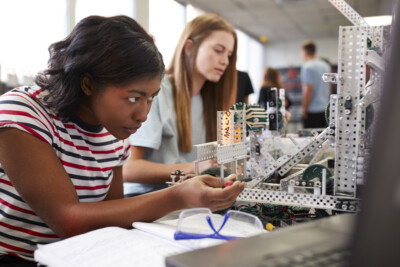Barriers for Girls in STEM
Did you know that by middle school, girls’ interest in STEM fields plummets by 30% compared to boys [SheHeroes]? Negative stereotypes, lack of representation, and the confidence gap are all factors that contribute to this alarming trend. Addressing the key barriers that girls face in pursuing STEM education is crucial to ensuring their continued interest and participation in these fields.
The lack of representation of women in STEM fields sends a strong message that these domains are not welcoming or suitable for girls. Girls may struggle to envision themselves successfully pursuing these careers without female role models or mentors. This lack of representation further reinforces negative stereotypes and hinders their interest in STEM.
Take the first step towards closing the gender gap!
Lack of Female Role Models
When it comes to the lack of female role models, society often falls short in providing women with relatable and inspiring figures to look up to. This scarcity has far-reaching consequences, as it can discourage young girls from pursuing their dreams and limit their aspirations. The absence of female role models not only hinders women’s ability to recognize their full potential but also perpetuates gender disparities in STEM fields. By addressing this gap, we can pave the way for a more inclusive and equal society, empowering women to thrive in any field they choose.
Impact on Young Girls’ Aspirations and Confidence in Pursuing STEM Careers
Limited educational opportunities, implicit biases, and lack of representation have a significant impact on young girls’ aspirations and confidence in pursuing STEM careers. First, limited educational opportunities play a major role in hindering girls’ interest and confidence in STEM. In many parts of the world, girls face barriers such as inadequate access to quality STEM education, limited resources, and outdated gender stereotypes that discourage them from pursuing these fields.

Implicit biases, which are unconscious beliefs or attitudes that influence our behavior, contribute to the lack of confidence among girls in STEM. These biases can manifest in teachers, classmates, and even within the girls themselves, leading to self-doubt and lower self-esteem. When girls are constantly exposed to biases suggesting that they are less capable in STEM, they may begin to internalize these beliefs, resulting in limited aspirations and confidence to pursue STEM careers.
“Despite literally being in the top percentage of my class, professors and industry engineers regularly assumed I knew less than my male peers. It was very frustrating and ironic that in a field based on math and logic, so many illogical gender-biased assumptions were projected onto me and other women classmates.” Amanda Capone, 2023 Masters in Structural Engineering, UC Berkeley Graduate
The lack of women role models in STEM fields perpetuates the cycle of limited aspirations among young girls. When girls do not see other women succeeding and thriving in STEM careers, they may not believe that they have the ability to do the same. This lack of visible representation can be a significant barrier to girls’ confidence in pursuing STEM.
Unconscious Biases
Unconscious biases, also called implicit biases, are the automatic and unconscious associations, attitudes, and stereotypes individuals hold about certain groups of people or topics. Even though these biases are unintentional and based on societal and cultural learning, they can significantly impact decision-making processes, perceptions, and behaviors. It is crucial to address unconscious biases in order to promote inclusivity, fairness, and equality in various aspects of life, such as education, healthcare, and the workplace. By shedding light on these biases and implementing strategies to mitigate their effects, individuals and organizations can work towards creating a more inclusive and unbiased society.
Stereotypes and Societal Expectations Affecting Girls’ Interest In STEM Subjects
Stereotypes and societal expectations play a significant role in shaping girls’ interest in STEM subjects. From an early age, girls are often exposed to stereotypes that portray STEM as masculine and not suited for them. They may internalize these gendered messages, leading them to perceive STEM as less interesting or not for them. Societal expectations further reinforce these stereotypes by placing greater emphasis on girls’ abilities in non-STEM subjects, such as language arts or social sciences.

The negative impact of gender bias and stereotypes on girls’ motivation and career choices in STEM fields cannot be overstated. Research shows that girls who possess an initial interest in STEM may lose motivation and confidence as they grow older. These biases can discourage girls from pursuing STEM careers, resulting in a gender disparity that persists in these fields.
Women face numerous barriers and challenges in STEM workplaces. They often encounter bias and discrimination, which can hinder their career progress and influence their job satisfaction. Initiatives to bridge the gender gap in these fields are essential, as they can help address these challenges and break down the barriers that women face.
Empower girls in your classroom with Let's Go Learn!
Influence of Teachers and Peers on Girls’ Perception of Their Abilities in STEM
Teachers and peers have a significant influence on girls’ perception of their abilities in STEM. Teachers can shape the beliefs and confidence levels of their students by the way they teach and interact with them in the classroom. If teachers inadvertently reinforce gender stereotypes or display biases against women in STEM, girls may develop a negative perception of their abilities. On the other hand, encouraging and supportive teachers who believe in the capabilities of their female students can empower and inspire girls to pursue STEM fields.
Peers also play a crucial role in shaping girls’ perceptions of their abilities in STEM. The peer culture in schools often perpetuates stereotypes by reinforcing that STEM fields are mainly for boys. Girls may feel isolated or discouraged if they don’t see other girls showing an interest or succeeding in STEM subjects. Peer pressure and social dynamics can contribute to girls doubting their abilities and feeling like they don’t belong in STEM.
Addressing the gender gap in STEM fields requires a multi-pronged approach. By dismantling stereotypes, fostering supportive environments, and encouraging girls from a young age, we can empower them to pursue their full potential in these exciting and ever-evolving fields.


Leave A Comment